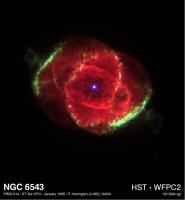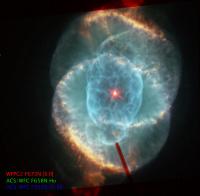Printable Version of Topic
Click here to view this topic in its original format
Unmanned Spaceflight.com _ Sun _ Death of the Sun
Posted by: ljk4-1 Mar 20 2006, 09:52 PM
National Geographic Channel
MONDAY, MARCH 20, 2006
***PREMIERE***
Naked Science: "Death of the Sun" at 9 PM et/pt
The life-giving sun is the most powerful force in our solar system. But
the sun is aging and eventually it will die. Can Earth survive without it?
Watch a preview.
http://newsletters.nationalgeographic.com/a/tBEHxfdASJ4TXAdOHR$AOOv6R.ASJ-ROGy/ngs18
Posted by: angel1801 Mar 21 2006, 11:48 AM
MONDAY, MARCH 20, 2006
***PREMIERE***
Naked Science: "Death of the Sun" at 9 PM et/pt
The life-giving sun is the most powerful force in our solar system. But
the sun is aging and eventually it will die. Can Earth survive without it?
Watch a preview.
http://newsletters.nationalgeographic.com/a/tBEHxfdASJ4TXAdOHR$AOOv6R.ASJ-ROGy/ngs18
I cannot possibly watch this show, but I do remember something. Long before the Sun dies, it will get bigger and more bloated in about a billion years time. The bloated Sun will consume all the inner planets (Mercury, Venus, Mars) and will move the outer planets (and its moons) inward quite a bit. Then the Sun will explode and become a brown dwarf that will emit its remaining radiation and light over the next billions of years.
Bodies like Europa and Titan will be changed so much that that Europa's thick ice cover will melt and Titan could begin life anew!
Posted by: Toma B Mar 21 2006, 12:02 PM
Didn't you mean white dwarf?
Surrounded buy planetary nebula...
Something like this:
Posted by: angel1801 Mar 21 2006, 12:10 PM
B)-->
Did you mean white dwarf? Surrounded buy planetary nebula...
Something like this:
[/quote]
I'm sorry. I was refering to something like a cold Jupiter type object which would only be a tiny fraction of the size of the Sun right now and would emit radiation forever more. I got to know this by watching "Cosmos" (Episode 9) I think.
If you can see this series, see Episode 11. It has a wonderful aerial spanning shot of the now defunct World Trade Towers and a wonderful message for mankind right at the end of it.
Posted by: Thorsten Mar 21 2006, 01:17 PM
One problem that I have with a body like Titan that will experience Earth-like temperatures is that due to Titans low (Earth-moon like) surface gravity it will probably lose its water content very fast into space. So after a (astronomical) short period Titan would look very similar to our Moon. I fear that when our sun turn nova, there won't be any biological winners, only losers!
Posted by: ljk4-1 Mar 21 2006, 01:52 PM
Bodies like Europa and Titan will be changed so much that that Europa's thick ice cover will melt and Titan could begin life anew!
A few fact corrections here:
The Sun will expand into a red giant and very likely consume Mercury and Venus
(assuming our distant descendants or whatever intelligent beings are inhabiting
our Sol system by then don't do something radical with the planets and moons, such
as turn everything into a Dyson Shell and "fix" the Sun so it will keep fusioning for
billions of years more) but due to its lessened mass as a red giant, Earth and the
rest of the planets may actually move outwards in their solar orbit. That will not
save it from being deeply fried, but Earth may not be consumed by the Sun, either.
As for the biological fates of Mars, Europa, Titan, and Enceladus - has anyone
ever run a computer simulation on this, even just for curiousity's sake?
The Sun also will not explode, at least certainly not like a nova or supernova.
It isn't massive enough for that or for crushing itself into a black hole. After a few
billion years, it will shrink to first a white dwarf and then a black dwarf, essentially
a dead star. I don't think it will even be at the brown dwarf stage.
Posted by: Phillip Mar 21 2006, 02:27 PM
Is it correct to say that our sun is a second generation star, meaning that it has gone through one prior cycle of expansion and then contraction to its present state? Is it also true that the Kuiper Belt represents the outer edge of the sun's expansion and is what was left behind after the Sun contracted to its present size?
I know I have read this in the past (or something like it) but now can't find anything to confirm/deny it. Can anyone help? Thanks,
Phillip
Posted by: AndyG Mar 21 2006, 03:59 PM
Second generation here means that the sun contains a proportion of heavy elements dating back to its formation. These elements were made in massive first-generation stars, which were released back into space during supernovae events that marked the ends of their lives.
The sun coalesced from material in the early solar nebula, hasn't and won't noticeably expand until it moves off the Main Sequence as its fuel is used up in a few billion years or so. It'll then swell as it evolves into a red giant.
Kuiper belt objects are part of the original mix that coalesced to form the Solar system, just like the other planets, though it's possible they are more pristine being so far away and cold. Further out, the Oort cloud marks the boundary of objects that are (just, barely) gravitationally bound to the sun.
Andy
Posted by: Myran Mar 22 2006, 02:33 AM
Its quite unlikely our sun will become a nova, according to one currect theory most novas do in fact occur in close binary star systems where matter flow over from one burning star to one older burned out one like a white dwarf that after it have accumulated enough matter on the surface and will burn it all in one outburst.
Supernovas are something that can happen for single stars, yet our sun have far too little mass to end that way.
Posted by: ljk4-1 Jun 19 2006, 04:29 PM
For those who missed it the first time, the National Geographic Channel
will be rebroadcasting the program "Death of the Sun" this Wednesday,
June 21, at 10P et/pt.
On the summer solstice, no less.
Watch a preview here:
http://newsletters.nationalgeographic.com/a/tBElsoSASJ4TXAilXUVAOOv6R.ASJ-ROjU/ngs21
Posted by: JRehling Jun 19 2006, 09:54 PM
Hey, when I see subject lines like this one...
Don't scare me like that!
Posted by: Jyril Jun 19 2006, 10:10 PM
If I remember correctly, Neptune might be suitably warm when Sun reaches its second red giant phase before it dies. Anyway, at that time the habitable zone will be far past the orbit of Saturn. The habitable zone naturally advances and retreats as Sun's luminosity changes, and heavy mass loss widens the orbits of planets drastically (which may save Earth from getting absorbed by Sun). Warming Sun doesn't make things easier on Titan, because the moon has retained its thick atmosphere partly because it is so cold.
Posted by: AlexBlackwell Jun 19 2006, 10:19 PM
In this http://www.unmannedspaceflight.com/index.php?s=&showtopic=2505&view=findpost&p=48072, I mentioned a paper by Alan Stern in the journal Astrobiology that might interest you.
Posted by: Richard Trigaux Jun 20 2006, 08:41 AM
Perhaps many red giants trigger life on some of their planets, due to transcient heat. After what we know, life can start quickly and the red giant stage lasts tens of millions years. But of course, we cannot expect more that primitive microbian life.
In the red giant stage of our sun:
-Venus, if it survives, will become cooler (after extinction of the sun), see icy, but eventually with some volcanic oasis where life could (very unlikely) start.
-Earth will be hotter and hotter, lowering biodiversity (evolved species disappearing first, due to lesser adaptability) until it triggers an runaway of greehouse effect and becomes Venus-like. After the end of the sun, it will become cooler and cooler, see icy, life subsisting only as microbes in some volcanic oasis, for many billions of years.
-Mars will become hotter, with liquid water on its surface. If life existed, it will appear on the surface. But it is unlikely it would appear, due to the scarcity of water, providing very few suitable places. (some salty lakes in bottom places).
-Io will not change
-Other Jupoter icy moons could become oceans of liquid water. Depending of chemicals present (salty, acidic...) Very suitable conditions could appear for the appearance of microbian life, but offering no opportunity of a complex evolution. Eventualy these oceans will evaoorate in space.
-Same for Saturn icy moons, except Titan.
-Moons of Uranus, Neptune, Pluto, KBOs, etc... will get hotter, but probably not un-freeze. Evetually some will get a temporary atmosphere of methane, nitrogen and the like.
-Titan is the more difficult to predict, but the more interesting. It is likely that its ice will become liquid (thanks to its greehouse effect) and it evaporates more slowly than other moons, thanks to its higher mass. So life could appear, but this, again, will depend on chemical conditions.
Posted by: ngunn Jun 20 2006, 10:24 AM
In Olaf Stapledon's remarkable book 'Last and First Men' humanity re-engineers itself and goes to Neptune when the sun becomes a red giant.
There is also a nice description in Wells's 'Time machine' of the red giant sun being watched by the last surviving Earth life (giant crabs).
Posted by: Jyril Jun 20 2006, 03:39 PM
Stapledon's book is badly outdated in the scientific sense. Of course, that doesn't mean that it isn't excellent book.
For non-fiction books on our planet's future, The Life and Death of Planet Earth, by Peter Ward and Donald Brownlee is excellent if not frustratingly pessimistic view of our planet's future.
Posted by: ljk4-1 Jun 20 2006, 03:55 PM
I also recommend this book:
Adams, Fred; Gregory Laughlin (2000). The Five Ages of the Universe: Inside the
Physics of Eternity. Simon & Schuster Australia. ISBN 0684865769.
The death of the Sun is just the mere starting off point for how far this work
examines the Ultimate End of Everything.
http://en.wikipedia.org/wiki/Ultimate_fate_of_the_universe
Posted by: nprev Jun 21 2006, 02:36 AM
Adams, Fred; Gregory Laughlin (2000). The Five Ages of the Universe: Inside the
Physics of Eternity. Simon & Schuster Australia. ISBN 0684865769.
The death of the Sun is just the mere starting off point for how far this work
examines the Ultimate End of Everything.
http://en.wikipedia.org/wiki/Ultimate_fate_of_the_universe
As always, thought-provoking...thanks, ljk4-1!
Speaking skeptically in order to examine core assumptions, I do have to wonder about all these apparent tie-ins between information theory and avant-gard cosmology; is there some sort of fundamental attribution error at work here? After all, IT is the vanguard scientific discipline of our civilization right now, so it is tempting to frame other problems exclusively in this context.
Conversely, our daily Newtonian physics seems to be the manifest result of inherent statistical determinism derived from quantum randomness (taken to an infinite limit of samples); does IT provide similar constraints in these models? This would, in my opinion, serve as the touchstone for theoretical rigor.
Posted by: helvick Jul 16 2006, 12:32 PM
A very interesting paper that explains the scale of a supernova explosion in terms that are quite easy to grasp
http://www.nagt.org/files/nagt/jge/abstracts/Dutch_v53n1.pdf
Powered by Invision Power Board (http://www.invisionboard.com)
© Invision Power Services (http://www.invisionpower.com)


